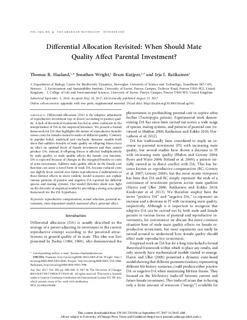| dc.contributor.author | Haaland, Thomas | |
| dc.contributor.author | Wright, Jonathan | |
| dc.contributor.author | Kuijper, Bram | |
| dc.contributor.author | Ratikainen, Irja Ida | |
| dc.date.accessioned | 2019-02-27T12:42:10Z | |
| dc.date.available | 2019-02-27T12:42:10Z | |
| dc.date.created | 2017-08-28T16:10:01Z | |
| dc.date.issued | 2017 | |
| dc.identifier.citation | American Naturalist. 2017, 190 (4), . | nb_NO |
| dc.identifier.issn | 0003-0147 | |
| dc.identifier.uri | http://hdl.handle.net/11250/2587808 | |
| dc.description.abstract | Differential allocation (DA) is the adaptive adjustment of reproductive investment (up or down) according to partner quality. A lack of theoretical treatments has led to some confusion in the interpretation of DA in the empirical literature. We present a formal framework for DA that highlights the nature of reproductive benefits versus costs for females mated to males of different quality. Contrary to popular belief, analytical and stochastic dynamic models both show that additive benefits of male quality on offspring fitness have no effect on optimal levels of female investment and thus cannot produce DA. Instead, if offspring fitness is affected multiplicatively by male quality, or male quality affects the female cost function, DA is expected because of changes in the marginal benefits or costs of extra investment. Additive male quality effects on the female cost function can cause a novel form of weak DA, because reduced costs can slightly favor current over future reproduction. Combinations of these distinct effects in more realistic model scenarios can explain various patterns of positive and negative DA reported for different species and mating systems. Our model therefore sheds new light on the diversity of empirical results by providing a strong conceptual framework for the DA hypothesis. | nb_NO |
| dc.language.iso | eng | nb_NO |
| dc.publisher | University of Chicago Press | nb_NO |
| dc.relation.uri | http://www.journals.uchicago.edu/doi/full/10.1086/693484 | |
| dc.rights | Navngivelse 4.0 Internasjonal | * |
| dc.rights.uri | http://creativecommons.org/licenses/by/4.0/deed.no | * |
| dc.subject | Evolusjonsbiologi | nb_NO |
| dc.subject | Evolutionary biology | nb_NO |
| dc.subject | Atferdsøkologi | nb_NO |
| dc.subject | Behavioural ecology | nb_NO |
| dc.subject | Livshistorieevolusjon | nb_NO |
| dc.subject | Life-history evolution | nb_NO |
| dc.title | Differential allocation revisited: When should mate quality affect parental investment? | nb_NO |
| dc.type | Journal article | nb_NO |
| dc.type | Peer reviewed | nb_NO |
| dc.description.version | publishedVersion | nb_NO |
| dc.subject.nsi | VDP::Etologi: 485 | nb_NO |
| dc.subject.nsi | VDP::Ethology: 485 | nb_NO |
| dc.source.pagenumber | 13 | nb_NO |
| dc.source.volume | 190 | nb_NO |
| dc.source.journal | American Naturalist | nb_NO |
| dc.source.issue | 4 | nb_NO |
| dc.identifier.doi | 10.1086/693484 | |
| dc.identifier.cristin | 1489133 | |
| dc.relation.project | Norges forskningsråd: 240008 | nb_NO |
| dc.description.localcode | © 2017 by The University of Chicago. All rights reserved. This work is licensed under a Creative Commons Attribution 4.0 International License (CC BY 4.0), which permits reuse of the work with attribution. | nb_NO |
| cristin.unitcode | 194,66,10,0 | |
| cristin.unitname | Institutt for biologi | |
| cristin.ispublished | true | |
| cristin.fulltext | original | |
| cristin.qualitycode | 2 | |

